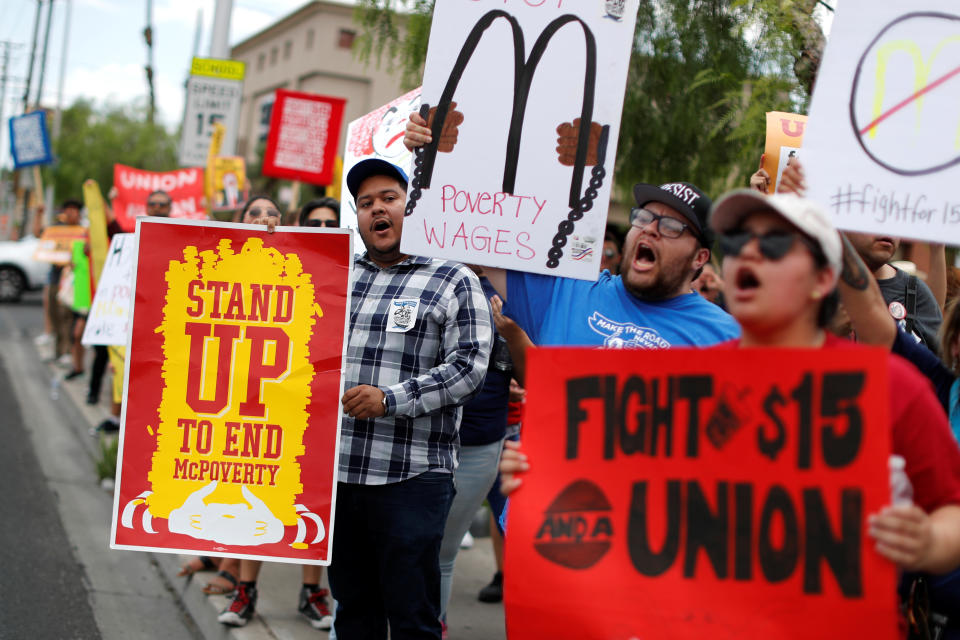Here's what a higher minimum wage really does to job growth
I’ve been seeing all kinds of blather lately that increasing pay — particularly a higher minimum wage — is killing job growth. Meaning that because employers have to pay more in salaries, they aren’t hiring, or are even firing workers.
My response to that?
Please.
In fact, what we’ve seen lately in the job market should finally put that old canard — higher pay leads to job losses — to rest.
Fact One: The effective minimum wage (I’ll spell this out below) has been soaring recently and is at an all-time high.
Fact Two: At 3.5%, the U.S. unemployment rate hasn’t been this low since December 1969, almost exactly half a century ago. Nixon was in the White House, Neil Armstrong was on the moon, and the hippies were at Woodstock. A long time ago.

That’s pretty much it, case closed, except for another fact. That is, I think employers, business owners, and CEOs sometimes use higher wages, particularly those mandated by the government (i.e. minimum wage hikes), as an excuse or cover for weak performance by their businesses — and/or for other reasons.
Further, if you see a business predicated on paying workers the current federal minimum wage of $7.25, you have to ask yourself what kind of a life is that company providing for its employees.
I’ll tell you what kind of life.
That $7.25 an hour works out to be $15,080 a year. Federal guidelines mandate that a salary of $21,330 or below for a family of three is at poverty level and is eligible for certain federal programs including the Supplemental Nutrition Assistance Program, formerly known as food stamps. (Ok, sure, for an individual the poverty level is a salary of $12,490. Still.)
I’m not saying that pay hikes aren’t real money for an employer, particularly for a small business owner with a few employees. But the federal minimum wage hasn’t been raised since July 2009. If you haven’t factored in giving your workers a raise in, what, 123 months, I would submit you aren’t so hot in the planning department.
Or you’re taking advantage.

So if the federal minimum wage is $7.25, what do I mean by the effective minimum wage and why has that been climbing? First, understand that the federal minimum wage is binding only in 21 states, mostly in southern and western states. The other 29 have state minimum wages, all higher than the federal bar, and now some cities like New York City and Seattle are raising the bar, as well.
According to The New York Times, if you average all these minimums across the country, you get an effective national minimum wage of $11.80. That’s the number that I said has soared over the past decade — just as the unemployment rate was plummeting — and is at an all-time high.
Furthermore, it’s tough to make the case that the states with the low, federal minimum wage threshold have better economies.
And yet, businesses still complain. New York City raised its minimum wage to $15 an hour in December and there was predictable howling, with some restaurant owners complaining they had to shut their steak house or Mexican restaurant because of higher wages (even though there are thousands of similar, thriving places). In any event, these are in fact real costs and it’s a hot button issue — I understand that. But get beyond the emotion and look at the numbers and you see another picture.
Yannet Lathrop, a researcher with the National Employment Law Project, co-authored a report on NYC restaurants showing that after five years of minimum wage increases, New York City’s restaurant industry is thriving. “People do feel passionately about the minimum wage increase,” says Lathrop. “[But the] overwhelming body of evidence suggests minimum wages do what [they’re] supposed to do: increase wages for workers affected and no distinguishable effects on employment. You can go by what you feel about minimum wage personally, or by what data says.”
Greg Biryla, state director for the National Federation of Independent Business, a group that advocates for small businesses, disagrees, saying higher wages have been “a significant burden. It’s raised the cost of doing business, raised the cost of hiring, raised the cost of growth.”
He might be right. But on the other hand this ignores that higher wages have benefitted millions of Americans who need help the most. It’s the right kind of trade-off if you ask me, particularly in this era of high income and wealth inequality.
Sure, there are differences in the cost of living between, say, Seattle ($16.09 minimum wage) and Buffalo (most affordable city in the U.S.). But increasingly, states may be looking to differentiate themselves based on wages, leading to more disparity and leverage available to states, a trend I’ve noted recently.
One last question: Is all this state-wide minimum wage lifting causing overall wages to spike, maybe too much?
Doesn’t look like it.
The September jobs report showed wage growth of just 2.9%, the lowest rate since July 2018.
What it looks like to me is that working poor people are finally getting a boost. And companies with business models based on paying people poverty level wages that haven’t risen in 10 years (!) are getting squeezed a bit.
Gee.
This article was featured in a special Saturday edition of the Morning Brief on October 12, 2019. Get the Morning Brief sent directly to your inbox every Monday to Friday by 6:30 a.m. ET. Subscribe
—
Andy Serwer is editor-in-chief of Yahoo Finance. Follow him on Twitter: @serwer.
Read more:
Facebook's Zuckerberg and Sandberg are this involved with the company's content issues
Negative interest rates are coming and they are downright terrifying
Follow Yahoo Finance on Twitter, Facebook, Instagram, Flipboard, SmartNews, LinkedIn, YouTube, and reddit.
